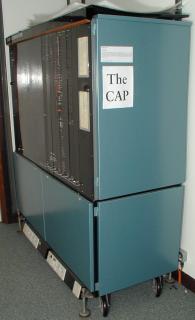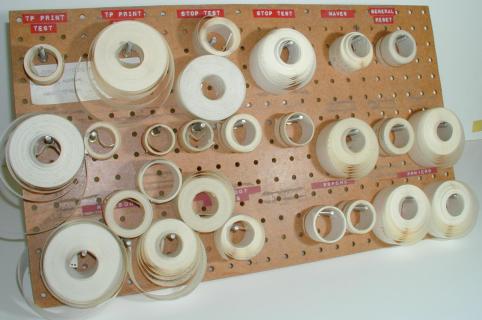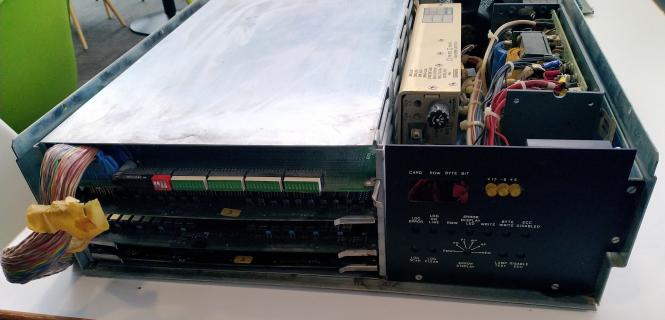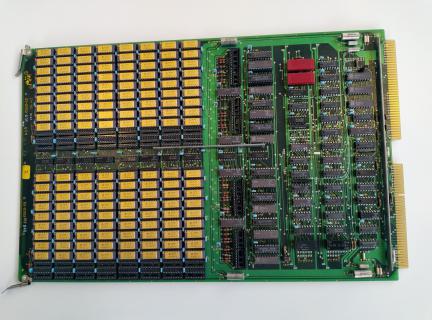The Computer Laboratory Relics Database
The database contains details of over 200 artifacts ranging from turn of the century calculating machines, through pieces of our early electronic machines (EDSAC I and II), to bits and pieces built for specific research projects, or extracted from interesting commercial machines.
There are also still significant holes in the database, being filled as time permits. All information and photographs produced by this Search facility are subject to the departmental Relics Project copyright and license terms.
Unique id/year of acquisition: CL-87/99
Name: Cap paperwork
Photograph not applicable
Other No marked on object:
Inscription:
Dimensions:
Description:
Class: documentation
Machine name: CAP
Condition:
Notes:
Unique id/year of acquisition: CL-98/99
Name: The CAP

Other No marked on object:
Inscription:
Dimensions:
Description:
Class: computer
Machine name: CAP
Condition:
Notes: The CAP (Capability Protection) Project ran from 1970 to 1977.It was an experiment in memory protection, based on capabilities implemented in hardware, under M.V.Wilkes and R.M.Needham with D.Wheeler responsible for implementation (BCS Technical Award 1978 for `CAP (Capability Protection) Project' to R.M.Needham).
Unique id/year of acquisition: CL-99/99
Name: CAP Philips store Control Panel

Other No marked on object:
Inscription:
Dimensions:
Description:
Class: computer
Machine name: CAP
Condition:
Notes: The Phillips core store was a later add-on to the CAP. It provided 120k 32-bit words, but was rather slow as the words were byte addressed.
Unique id/year of acquisition: CL-100/99
Name: Paper Tape Library

Other No marked on object:
Inscription:
Dimensions:
Description:
Class: other
Machine name: CAP
Condition:
Notes: A selection of paper tapes containing subroutines which could be physically copied and stuck together to form parts of larger programs. This technique was common to most computers until the 1970s.
Correction from Martyn Johnson:These paper tapes were not a subroutine library and they were not joined together. Each paper tape was a standalone microprogram for the CAP. Mostly they are test programs of various kinds and some bootstraps. There is probably also a paper tape copy of the microcode that ran the normal instruction set of the machine, though in the latter days this was more normally loaded from disc or network.
See also: CL-64/99
See also: CL-81/99
See also: CL-96/99
See also: CL-126/99
Unique id/year of acquisition: CL-172/24
Name: CAP DRAM Memory System



Other No marked on object: none
Inscription:
Dimensions: dimensions missing
Description:
Class: peripheral
Machine name: CAP
Condition: good
Notes: This was the second main memory used with the CAP computer. It uses two types of DRAM chip spread over four PCBs (made by Intel in 87 and 80). A fifth PCB was locally made (by Martyn Johnson) and is a wire-wrapped set of line drivers for the twisted ribbon cables to the CAP machine. This also has a number of LED indicators, presumably indicating the status of each address and data line.
This unit replaced 64K (?) of 48-bit fast (4us, 6us?) Plessey core store that was ex-Titan and a slow (10us, 12us?) 128K 32-bit Philips core store.
The store had a mid-life upgrade when 64K chips became available. 64K-bit chips were part of a bulk purchase deal arrange through Acorn who were buying them for their production and, because they bought in bulk, gained access to 64K chips ahead of the general market.
Fortunately the only change required after replacing the RAM chips was to snip off the decoupling capacitors on what was previously a ground line and now an address line. Andrew Herbert recalls feeling rather smug about quadrupling the size of the store that easily.
There are three blades each providing 128 kbyte using MOSTEK 4116-3 16-kbit DRAMs. The fourth blade has Hitachi HM4864-3 64-kbit devices and provides 128 kbyte. The total capacity of the unit is therefore 224 kbytes.
Notes
- Identifiers are written on objects in the format CL-uuu/yy/gg (u = unique identifier, y = year of acquisition or entry into database, g = group id. The group id is only used if there are more than one of a given object.) eg 80/99/3. This format was adopted to make the identifiers from this exercise distinct from any used in previous cataloguing attempts.
- Photographs. Where relevant the database contains a comma-separated list of Unix path names of pictures of the object, in jpeg format. If photos are available a thumbnail image will be shown as a search result. Click on this to see the full size image.
- Date format: dd.mm.yy
- Name format: Full first name (where known), else initial and surname
- Dimensions: max x next x min (all in mm)
- Lists in all fields are comma separated.
- n/a = not applicable
blank = no information entered
? = information uncertain or unknown
The database search allowed by this page is selective and will only display information that is present, i.e. it will not display labels for empty fields. - Not all information in the database is displayed on the web page produced by this search facility, some of it is private (eg location of object, for security reasons).
- The Notes section of the database may contain html formatting commands to allow it to be displayed to best advantage on the web pages output by this search facility.